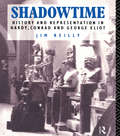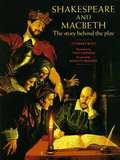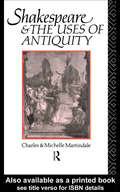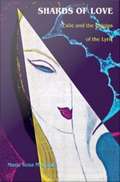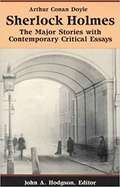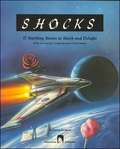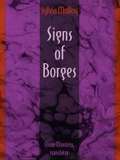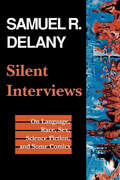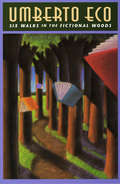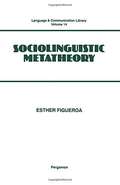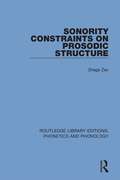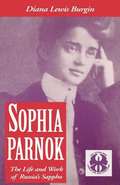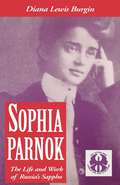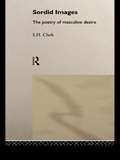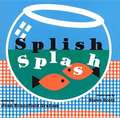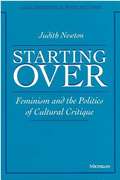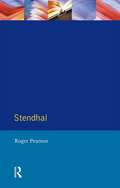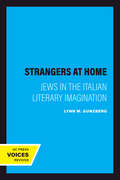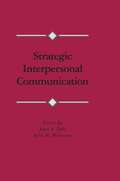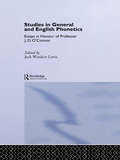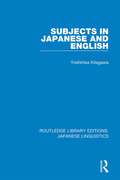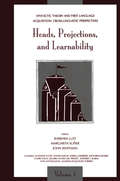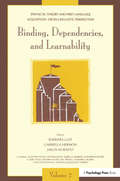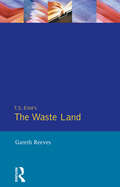- Table View
- List View
Shadowtime: History and Representation in Hardy, Conrad and George Eliot
by Jim ReillyIn Shadowtime Jim Reilly explores how the great Victorian and Edwardian works of literature can be read in the light of current radical historiography, which foresees the extinction not just of art but of history itself. This is an outstanding combination of original readings and critical survey. Shadowtime is ideal material for anyone studying nineteenth-century realism, modernism and the history of aesthetics.
Shakespeare And Macbeth: The Story Behind the Play
by Stewart Ross Kenneth Branagh Tony KarpinskiHistorical finding and current critical thinking are woven together to tell the fascinating story of how Shakespeare conceived and wrote one of his greatest plays. As readers watch the production being mounted, Ross's narrative and Karpinski's carefully researched illustrations bring Shakespeare's world to vivid life. Full-color and black-and-white illustrations.
Shakespeare and the Uses of Antiquity: An Introductory Essay
by Michelle MartindaleAgainst a recent tendency to exaggerate Shakespeare's classical learning, this study examines how the playwright used his relatively restricted knowledge to create an unusually convincing picture of Rome.
Shards of Love: Exile and the Origins of the Lyric
by María Rosa MenocalWith the Spanish conquest of Islamic Granada and the expulsion of the Jews from Spain, the year 1492 marks the exile from Europe of crucial strands of medieval culture. It also becomes a symbolic marker for the expulsion of a diversity in language and grammar that was disturbing to the Renaissance sensibility of purity and stability. In rewriting Columbus's narrative of his voyage of that year, Renaissance historians rewrote history, as was often their practice, to purge it of an offending vulgarity. The cultural fragments left behind following this exile form the core of Shards of Love, as Mara Rosa Menocal confronts the difficulty of writing their history. It is in exile that Menocal locates the founding conditions for philology--as a discipline that loves origins--and for the genre of love songs that philology reveres. She crosses the boundaries, both temporal and geographical, of 1492 to recover the "original" medieval culture, with its Mediterranean mix of European, Arabic, and Hebrew poetics. The result is a form of literary history more lyrical than narrative and, Menocal persuasively demonstrates, more appropriate to the Middle Ages than to the revisionary legacy of the Renaissance. In discussions ranging from Eric Clapton's adaption of Nizami's Layla and Majnun, to the uncanny ties between Jim Morrison and Petrarch, Shards of Love deepens our sense of how the Middle Ages is tied to our own age as it expands the history and meaning of what we call Romance philology.
Sherlock Holmes: The Major Stories with Contemporary Critical Essays
by Arthur Conan Doyle John A. HodgsonContaining fifteen Sherlock Holmes stories, this volume of Sherlock Holmes features concise commentary on how each story relates to the author, the series, and the detective genre as well as nine accompanying essays which reflect the recent critical interest in Holmes and examine the stories from a variety of contemporary critical perspectives.
Shocks: 15 Startling Stories to Shock and Delight
by Burton GoodmanThis book contains 15 exciting stories by some of the world's greatest writers. As the title suggests, each story provides a shock. These tales offer you hours of reading pleasure. And the exercises that follow will help you improve your reading and literature skills.
Signs of Borges
by Sylvia Molloy Oscar MonteroAvailable for the first time in English, Signs of Borges is widely regarded as the best single book on the work of Jorge Luis Borges. With a critical sensibility informed by Barthes, Lacan, Foucault, Blanchot, and the entire body of Borges scholarship, Sylvia Molloy explores the problem of meaning in Borges's work by remaining true to the uncanniness that is its foundation.Borges's sustained practice of the uncanny gives rise in his texts to endless tensions between illusion and meaning, and to the competing desires for fragmentation, dispersal, and stability. Molloy traces the movement of Borges's own writing by repeatedly spanning the boundaries of genre and cutting across the conventional separations of narrative, lyric and essay, fact and fiction. Rather than seeking to resolve the tensions and conflicts, she preserves and develops them, thereby maintaining the potential of these texts to disturb. At the site of these tensions, Molloy locates the play between meaning and meaninglessness that occurs in Borges's texts. From this vantage point his strategies of deception, recourse to simulacra, inquisitorial urge to unsettle binarism, and distrust of the permanent--all that makes Borges Borges--are examined with unmatched skill and acuity.Elegantly written and translated, Signs of Borges presents a remarkable and dynamic view of one of the most international and compelling writers of this century. It will be of great interest to all students of twentieth-century literature, particularly to students of Latin American literature.
Silent Interviews: On Language, Race, Sex, Science Fiction, and Some Comics-A Collection of Written Interviews
by Samuel R. DelanySamuel R. Delany, whose theoretically sophisticated science fiction and fantasy has won him a broad audience among academics and fans of postmodernist fiction, offers insights into and explorations of his own experience as writer, critic, theorist, and gay black man in his new collection of written interviews, a form he describes as a type of "guided essay." Gathered from sources as diverse as Diacritics and Comics Journal, these interviews reveal the broad range of his thought and interests.
Simulacra and Simulation
by Jean Baudrillard Sheila Faria GlaserMoving away from the Marxist/Freudian approaches that had concerned him earlier, Baudrillard developed in this book a theory of contemporary culture that relies on displacing economic notions of cultural production with notions of cultural expenditure.
Six Walks in the Fictional Woods
by Umberto EcoIn this exhilarating book, we accompany Umberto Eco as he explores the intricacies of fictional form and method. Using examples ranging from fairy tales and Flaubert, Poe and Mickey Spillane, Eco draws us in by means of a novelist's techniques, making us his collaborators in the creation of his text and in the investigation of some of fiction's most basic mechanisms.
Sociolinguistic Metatheory (Language & Communication Library #14)
by Esther FigueroaLinguistics is a discipline with ever expanding boundaries and interests. Despite the narrow definition of linguistics which dominates academia, sub-fields continue to flourish and ways of doing linguistics continue to expand. As ways to do linguistics increase, and as approaches to linguistics accumulate over time, it becomes increasingly necessary for students of linguistics to have ways of understanding and comparing developments in linguistics. <p><p> Sociolinguistic Metatheory is a book which explains foundational developments in linguistics by taking the past three decades of developments in sociolinguistics and relating them to contemporaneous developments in received linguistics. Sociolinguistic Metatheory takes the reader through the basic philosophical questions which drive linguistic research. It looks in detail at three models of sociolinguistics - Dell Hymes and the Ethnography of Communication, William Labov and Sociolinguistic Realism, and John Gumperz and Interactional Sociolinguistics - and focuses on such questions as: Where is language located? How is an utterance-based approach to linguistics different from a sentence-based approach? How do metatheoretical paradigm assumptions such as realism or relativism affect the development of linguistic theory? What interesting developments in linguistic theory and analysis have sociolinguistics provided?
Sonority Constraints on Prosodic Structure (Routledge Library Editions: Phonetics and Phonology #23)
by Draga ZecFirst published in 1994. The goal of this study is to find the correlations between the internal constituency of the syllable and the sonority of segments. Its major claim is that valid correlations can be established only under the moraic theory of syllable-internal structure. This work thus represents an argument for the moraic theory of the syllable. This title will be of interest to students of language and linguistics.
Sophia Parnok: The Life and Work of Russia's Sappho
by Diana L. Burgin"The weather in Moscow is good, there's no cholera, there's also no lesbian love... Brrr! Remembering those persons of whom you write me makes me nauseous as if I'd eaten a rotten sardine. Moscow doesn't have them--and that's marvellous." Anton Chekhov, writing to his publisher in 1895. Chekhov's barbed comment suggests the climate in which Sophia Parnok was writing, and is an added testament to to the strength and confidence with which she pursued both her personal and artistic life. Author of five volumes of poetry, and lover of Marina Tsvetaeva, Sophia Parnok was the only openly lesbian voice in Russian poetry during the Silver Age of Russian letters. Despite her unique contribution to modern Russian lyricism however, Parnok's life and work have essentially been forgotten. Parnok was not a political activist, and she had no engagement with the feminism vogueish in young Russian intellectual circles. From a young age, however, she deplored all forms of male posturing and condescension and felt alienated from what she called patriarchal virtues. Parnok's approach to her sexuality was equally forthright. Accepting lesbianism as her natural disposition, Parnok acknowledged her relationships with women, both sexual and non-sexual, to be the centre of her creative existence. Diana Burgin's extensively researched life of Parnok is deliberately woven around the poet's own account, visible in her writings. The book is divided into seven chapters, which reflect seven natural divisions in Parnok's life. This lends Burgin's work a particular poetic resonance, owing to its structural affinity with one of Parnok's last and greatest poetic achievements, the cycle of love lyrics Ursa Major. Dedicated to her last lover, Parnok refers to this cycle as a seven-star of verses, after the seven stars that make up the constellation. Parnok's poems, translated here for the first time in English, added to a wealth of biographical material, make this book a fascinating and lyrical account of an important Russian poet. Burgin's work is essential reading for students of Russian literature, lesbian history and women's studies.
Sophia Parnok: The Life and Work of Russia's Sappho (The Cutting Edge: Lesbian Life and Literature Series)
by Diana L. BurginThe weather in Moscow is good, there's no cholera, there's also no lesbian love...Brrr! Remembering those persons of whom you write me makes me nauseous as if I'd eaten a rotten sardine. Moscow doesn't have them--and that's marvellous."-Anton Chekhov, writing to his publisher in 1895 Chekhov's barbed comment suggests the climate in which Sophia Parnok was writing, and is an added testament to to the strength and confidence with which she pursued both her personal and artistic life. Author of five volumes of poetry, and lover of Marina Tsvetaeva, Sophia Parnok was the only openly lesbian voice in Russian poetry during the Silver Age of Russian letters. Despite her unique contribution to modern Russian lyricism however, Parnok's life and work have essentially been forgotten. Parnok was not a political activist, and she had no engagement with the feminism vogueish in young Russian intellectual circles. From a young age, however, she deplored all forms of male posturing and condescension and felt alienated from what she called patriarchal virtues. Parnok's approach to her sexuality was equally forthright. Accepting lesbianism as her natural disposition, Parnok acknowledged her relationships with women, both sexual and non-sexual, to be the centre of her creative existence. Diana Burgin's extensively researched life of Parnok is deliberately woven around the poet's own account, visible in her writings. The book is divided into seven chapters, which reflect seven natural divisions in Parnok's life. This lends Burgin's work a particular poetic resonance, owing to its structural affinity with one of Parnok's last and greatest poetic achievements, the cycle of love lyrics Ursa Major. Dedicated to her last lover, Parnok refers to this cycle as a seven-star of verses, after the seven stars that make up the constellation. Parnok's poems, translated here for the first time in English, added to a wealth of biographical material, make this book a fascinating and lyrical account of an important Russian poet. Burgin's work is essential reading for students of Russian literature, lesbian history and women's studies.
Sordid Images: The Poetry of Masculine Desire
by Steve ClarkIn this extraordinary and bold book, S.H. Clark explores and constructs a history of poetic misogyny. For the first time, a wide range of English poetry by men is examined for evidence of the articulation of heterosexual masculine desires. But Clark goes beyond a straightforward oppositional model of reading the male canon, to ask how we read this work 'after feminism', and whether it is possible to value these texts as misogynist texts in the light of feminist theory? Sordid Images is a challenging, controversial book. It will excite and unsettle its readers, and inspire many to look again at some of the cornerstone works of English literature.
Splish Splash
by Joan Bransfield GrahamPresenting the many forms of water in concrete poems and graphic illustrations--including rain, snow, ocean waves, ice cubes, and tears--a clever book with bold illustrations plunges into the pleasures of poetry and the shapes of language.
Starting Over: Feminism and the Politics of Cultural Critique
by Judith NewtonFor more than a decade Judith Newton has been at the forefront of defining and promoting materialist feminist criticism. Starting Over brings together a selection of her essays that chart the establishment of feminist literary criticism in the academy and its relation to other forms of cultural criticism, including Marxist, post-Marxist, new historicist, and cultural materialist approaches, as well as cultural studies. The essays in Starting Over have functioned as exemplars of interdisciplinary thinking, mapping out the ways in which reading strategies and the constructions of history, culture, identity, change, and agency in various materialist theories overlap, and the ways in which feminist-materialist work both draws upon, revises, and complicates the vision of nonfeminist materialist critiques. They are shaped by an awareness that public knowledge is always informed by the so-called private realm of familial and sexual relations and that cultural criticism must bring together investigations of daily behaviors, economic and social relations, and the dynamics of race, class, gender, and sexual struggle. Starting Over is a brilliant synthesis of literature, history, anthropology, the many influential trends in contemporary theory, and the politics of feminism.
Stendhal: "The Red and the Black" and "The Charterhouse of Parma" (Modern Literatures In Perspective)
by Roger PearsonBoth critic and writer, Stendhal has now become established as one of realism's founding fathers. Dr Pearson's book maps out, for the first time, the critical reception of Stendhal's two most widely read novels, The Red and the Black and The Charterhouse of Parma since their publication in 1830 and 1839 respectively. In part one he provides generous samples of the most important nineteenth-century responses to the novels, almost all of them translated into English for the first time. Part two presents a full range of the most authoritative and influential readings since 1945, which illustrate a wide variety of critical approaches.
Strangers at Home: Jews in the Italian Literary Imagination
by Lynn M. GunzbergUsing popular literature as a window on Italian society and its values, Lynn Gunzberg explores the representation of Jews in novels and poetry written by non-Jews from the beginning of the Risorgimento in the early 1800s to the enactment of the Fascist racial laws in 1938. She shows how the literature of that period contradicts the popular belief that anti-Semitism simply did not exist in Italy until late in the Fascist period.
Strategic Interpersonal Communication (Routledge Communication Series)
by John A. Daly John M. WiemannThis book discusses how people go about achieving their social goals through human symbolic interaction. The editors' collective presumption is that there are more or less typical ways that people attempt to obtain desired outcomes -- be they persuasive, informative, conflictive, or the like -- through communication. Representing a first summary of research done by scholars, primarily in the communication discipline, this volume seeks to identify and understand how it is that people achieve what they want through social interaction. Under the very broad label of strategies, this research has sought to: * identify critical social goals such as gaining compliance, generating affinity, resolving social conflict, and offering information; * specify, for each goal, the ways, or strategies, by which people can go about achieving these goals; * determine predictors of strategy selection -- that is, why does a person opt for one strategy over others to obtain the desired end? The research also reflects the attention the field of communication has given to strategy issues in the past 15 years. The chapters describe research on the ways in which people achieve different goals, and summarize existing research and theory on the attainment of social goals. Readers will gain insight into many of the issues that exist regardless of the strategy being discussed. Thus, this volume may not include chapters on topics such as ways people elicit or offer disclosure, ways people demonstrate anger, or ways people create guilt, but the issues that appear consistently throughout the various chapters should apply equally to these. Finally, the essays in this volume provide not only a summary of what has been accomplished to date, but also an initial theoretic map for future research concerning strategic interpersonal communication.
Studies in General and English Phonetics: Essays in Honour of Professor J.D. O'Connor
by J. D. O'ConnorRhythm, intonation, exotic and familiar languages as well as computer-sythesized audio-communications, procedures in forensic linguistics, pronunciation lexicography, language change and sociological aspects of speech such as English regional accents and dialects in Britain and other parts of the world are covered in these thirty-eight articles in tribute to Professor J.D. O'Connor by an international list of contributors, including many world famous names. With an invaluable up-to-date bibliography, no university library will be complete without it.
Subjects in Japanese and English (Routledge Library Editions: Japanese Linguistics)
by Yoshihisa KitagawaOriginally published in 1994, this volume shows that the structural relation 'government' holds not only between the verbal head and its object but also between the verbal head and its subject at least at the level of Logical Form in both Japanese and English. The book provides an analysis of complex predicate constructions in Japanese, discusses phrase structure in Japanese and English and develops a theory of binding.
Syntactic Theory and First Language Acquisition: Cross-linguistic Perspectives -- Volume 1: Heads, Projections, and Learnability -- Volume 2: Binding, Dependencies, and Learnability
by John Whitman Claire Foley Suzanne Flynn Barbara Lust Margarita Suñer Shyam Kapur Isabella Barbier Katharina Boser Zelmira Nuñez del Prado Edward J. Rubin Lynn Santelmann Almeida Jacqueline ToribioUniversal Grammar (UG) is a theory of both the fundamental principles for all possible languages and the language faculty in the "initial state" of the human organism. These two volumes approach the study of UG by joint, tightly linked studies of both linguistic theory and human competence for language acquisition. In particular, the volumes collect comparable studies across a number of different languages, carefully analyzed by a wide range of international scholars. The issues surrounding cross-linguistic variation in "Heads, Projections, and Learnability" (Volume 1) and in "Binding, Dependencies, and Learnability" (Volume 2) are arguably the most fundamental in UG. How can principles of grammar be learned by general learning theory? What is biologically programmed in the human species in order to guarantee their learnability? What is the true linguistic representation for these areas of language knowledge? What universals exist across languages? The two volumes summarize the most critical current proposals in each area, and offer both theoretical and empirical evidence bearing on them. Research on first language acquisition and formal learnability theory is placed at the center of debates relative to linguistic theory in each area. The convergence of research across several different disciplines -- linguistics, developmental psychology, and computer science -- represented in these volumes provides a paradigm example of cognitive science.
Syntactic Theory and First Language Acquisition: Cross-linguistic Perspectives -- Volume 1: Heads, Projections, and Learnability -- Volume 2: Binding, Dependencies, and Learnability
by Claire Foley Suzanne Flynn Jaklin Kornfilt Barbara Lust Shyam Kapur Isabella Barbier Katharina Boser Zelmira Nuñez del Prado Edward J. Rubin Lynn Santelmann Gabriella Hermon Jacqueline ToribioUniversal Grammar (UG) is a theory of both the fundamental principles for all possible languages and the language faculty in the "initial state" of the human organism. These two volumes approach the study of UG by joint, tightly linked studies of both linguistic theory and human competence for language acquisition. In particular, the volumes collect comparable studies across a number of different languages, carefully analyzed by a wide range of international scholars. The issues surrounding cross-linguistic variation in "Heads, Projections, and Learnability" (Volume 1) and in "Binding, Dependencies, and Learnability" (Volume 2) are arguably the most fundamental in UG. How can principles of grammar be learned by general learning theory? What is biologically programmed in the human species in order to guarantee their learnability? What is the true linguistic representation for these areas of language knowledge? What universals exist across languages? The two volumes summarize the most critical current proposals in each area, and offer both theoretical and empirical evidence bearing on them. Research on first language acquisition and formal learnability theory is placed at the center of debates relative to linguistic theory in each area. The convergence of research across several different disciplines -- linguistics, developmental psychology, and computer science -- represented in these volumes provides a paradigm example of cognitive science.
T. S. Elliot's The Waste Land
by Gareth ReevesThis work argues that although "The Waste Land" demands close reading, the spirit of the old New Criticism works with inappropriate assumptions about unity and closed form. Many critics have tried to fix the text, to find hidden narratives and plots, spiritual guests and allegories of salvation. Instead, this reading sees the poem as resolutely open-ended, supporting this view with recent developments in Reader-Response criticism and Reception Theory. The study focuses on the way poetry sounds (or does not sound, cannot be sounded). It concentrates on syntax, lineation and intonation. It also brings out the presence of the muted voices of wronged women in a work often called misogynistic.
